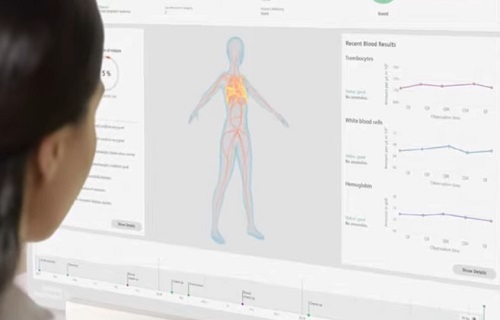When an unpredictable accidents happen or an injury our body come to help like have superpowers like a clotting. Clotting is like magic help item for survive and recovery and one of the secret weapon our body. We should to give our body needs for healthy life and we should a few test for sure if everything is ok. Especially blood test very important for determine insufficient vital proteins for clotting such as fibrinogen. You can read some tips clotting and fibrinogen in this article.


What is Clotting ?
Clotting, also known as coagulation, is the process the body stops bleeding from a blood vessel that has been injured. The process of clotting involves a series of chemical reactions that turn liquid blood into a solid or semi-solid state.
The process of clotting begins when an injury occurs and the walls of the blood vessel are damaged. This causes the platelets, which are small cells found in the blood, to become activated and stick to the site of the injury. The platelets then release chemical signals that attract other platelets and clotting factors to the site of the injury.
The clotting factors then activate a series of chemical reactions known as the clotting cascade. These reactions convert a protein called fibrinogen into fibrin. Fibrin is a fibrous protein that forms a mesh-like structure that traps red blood cells and forms a clot.
The formation of a clot is also helped by other clotting factors, like thrombin and calcium, which help to support the clot.
The process of clotting is a complex and certain balance between clotting and bleeding. Too much clotting can lead to conditions such as deep vein thrombosis, while too little clotting can cause to bleeding disorders such as hemophilia.
Last words : clotting is the process by which the body stops bleeding from a blood vessel that has been injured. It starts with the activation of platelets, which release some chemical signals that attract other platelets and clotting factors to the site of the injury. The clotting factors then activate a series of chemical reactions, known as the clotting cascade, which convert fibrinogen into fibrin, forming a clot.



What is Reasons Clotting Disorders ?
Insufficient clotting, also known as a bleeding disorder, can be caused by different factors. Some of the main factors of insufficient clotting include:
- Genetic bleeding disorders: such as hemophilia and Von Willebrand disease, are caused by genetic mutations that affect the function of clotting factors.
- Liver disease: The liver plays a vital role in the production of clotting factors. Damage to the liver can cause to decreased production of clotting, resulting in insufficient clotting.
- Vitamin K deficiency: Vitamin K is one of the crucial points for the production of clotting factors. Insufficient vitamin K can lead to insufficient clotting.
- Medications: Some drugs, such as blood thinners (e.g. heparin, warfarin) and antiplatelet drugs (e.g. aspirin), can delay with the normal clotting process and lead to insufficient clotting.
- Autoimmune disorders: Conditions like lupus and rheumatoid arthritis can cause the body to produce antibodies that attack clotting factors, leading to insufficient clotting.
- Cancer: Some types of cancer, like as leukemia and lymphoma, can delaying with the normal clotting process and lead to insufficient clotting.
- Severe trauma or injury: Severe trauma or injury can lead to significant blood loss and damage to the clotting system, cause to insufficient clotting.
- Blood disorders: Such as thrombocytopenia, can be reason of insufficient clotting by reducing the number of platelets in the blood.
It’s important to remember that in some cases, the cause of insufficient clotting may not be defined clearly. If a bleeding disorder is suspected, a healthcare provider will usually perform several tests to determine the cause, and determine the best treatment method.
Tips For Support Healthy Clotting
Here are some tips for supporting healthy clotting:
- Healthy Diet: Eating a diet that is rich in vitamins and minerals, such as vitamin K, vitamin C and iron, can help to support normal clotting.
- Healthy Liver: The liver plays a vital role in the production of clotting factors, so it is important to keep your liver healthy by avoiding alcohol and drugs, and by maintaining a healthy diet.
- Be Careful of Medications: If you are taking blood thinners or other medications that can interfere with normal clotting, it is important to be aware of the potential side effects and to follow your healthcare provider’s instructions carefully.
- Smoking: Smoking can damage the blood vessels and reduce the amount of oxygen that reaches the tissue, which can increase the risk of bleeding.
- Avoiding Overuse of Anti-Inflammatory Drugs: Overuse of anti-inflammatory drugs can cause to bleeding or clotting disorders.
- Regular Check-ups: If you have a history of bleeding disorders or if you are at risk of developing one, it is important to get regular check-ups with your healthcare provider.
It’s important to note that these tips are general recommendations, and that your individual needs may change according to your personal health status, any underlying conditions and medications you are taking. If you have any concerns about your clotting, it’s best to consult with your healthcare provider.
What is Fibrinogen ?
Fibrinogen is a protein that have a vital role in the blood clotting process. When an injury happens, the body releases fibrinogen into the bloodstream, which then converts to fibrin, forming a clot that helps to stop the bleeding. Fibrinogen is also known as Factor I and is a glycoprotein that is produced in the liver. It is composed of three pairs of non-identical polypeptide chains, Aα, Bβ, and γ, which are held together by disulfide bonds.
Fibrinogen-like protein 1 (FGL1) is a protein that is structurally similar to fibrinogen and has been found to play a role in the immune response. FGL1 binds to the Lymphocyte-activation gene 3 (LAG-3) protein, which is a starter of T-cell activation and is found on the surface of activated T-cells. FGL1-LAG3 interactions have been shown to play a role in regulating T-cell activation and the immune response.
The process of converting fibrinogen to fibrin is known as the clotting cascade. This cascade is activated when an injury occurs, and it involves a series of reactions that convert fibrinogen to fibrin. The first step in the process is the activation of Factor XII, which initiates the cascade by activating Factor XI. This is followed by the activation of Factor IX, which is activated by Factor VIII. The activated Factor IX then activates Factor X, which in turn activates Factor V. Factor V then activates prothrombin, which is converted to thrombin. Thrombin then converts fibrinogen to fibrin, which forms a clot.
Fibrinogen testing is used to measure the levels of fibrinogen in the blood. It is typically ordered when a person is suspected of having a clotting disorder or when they have a history of bleeding or clotting disorders. The test is usually performed on a sample of blood that is collected from a vein in the arm. The sample is then sent to a lab for analysis. The results of the test are usually reported as a fibrinogen level in milligrams per deciliter (mg/dL) of blood.
In conclusion, fibrinogen have a vital role in the blood clotting process and is produced by the liver. FGL1 and LAG3 are proteins that are structurally similar to fibrinogen and are involved in the immune response. The process of converting fibrinogen to fibrin is known as the clotting cascade and is activated when an injury happens. Fibrinogen testing is used to determine the levels of fibrinogen in the blood.



What is Symptoms of Fibrinogen Deficiency ?
Fibrinogen deficiency, also known as hypofibrinogenemia, is a condition in which the body does not have sufficient fibrinogen. Fibrinogen deficiency can be heredity or acquired.
Symptoms of fibrinogen deficiency can include:
- Prolonged bleeding after injury or surgery
- Easy bruising
- Nosebleeds
- Heavy menstrual bleeding
- Blood in the urine or stool
- Petechiae (small red or purple spots on the skin)
- Hematomas (collections of blood outside of blood vessels)
- Delayed wound healing
Symptoms of fibrinogen deficiency can change to depending on the severity of the deficiency. Some people with mild fibrinogen deficiency may not have any symptoms at all, while others with severe deficiency may have significant bleeding issues.
It’s important to note that some symptoms can be caused by other underlying conditions, so if you experience any of these symptoms, it’s important to talk to your doctor to determine the cause. If fibrinogen deficiency is diagnosed, treatment will typically involve replacement therapy with fibrinogen concentrate.
What is Causes of Fibrinogen Deficiency ?
Fibrinogen deficiency can be caused by both hereditary and other factors.
Inherited reasons of fibrinogen deficiency include:
- Familial hypofibrinogenemia: Genetic disorder that is inherited in an autosomal recessive pattern, which means that a person must inherit two copies of the defective gene, one from each parent.
- Afibrinogenemia: Very rare genetic disorder that is inherited in an autosomal recessive pattern, in which a person does not produce any fibrinogen.
Other causes of fibrinogen deficiency include:
- Liver disease: The liver is responsible for producing fibrinogen, so any damage to the liver can lead to decreased production of fibrinogen.
- DIC (disseminated intravascular coagulation): Serious medical condition that can occur as a complication of other medical conditions. It causes abnormal clotting and bleeding, cause to fibrinogen deficiency.
- Vitamin C deficiency: Vitamin C is important for the production of fibrinogen and deficiency can cause to decreased production.
- Malnutrition: Lack of essential nutrients, including protein, can lead to decreased production of fibrinogen.
- Some Medications: Some medications, such as heparin, warfarin and aspirin, can lead to decreased production of fibrinogen.
Tips For Healthy Fibrinogen Level
Here are some tips for keeping healthy fibrinogen levels:
- Eat a healthy diet: Eating a diet that is rich in protein and other essential nutrients can help to support healthy fibrinogen levels.
- Maintain a healthy weight: Being overweight or obese can lead to the risk of developing liver disease, which can lead to decreased production of fibrinogen.
- Avoid alcohol and drugs: Excessive alcohol consumption and drug use can damage the liver and reduce the production of fibrinogen.
- Exercise regularly: Regular exercise can help to improve overall health, including liver function.
- Get enough vitamin C: Vitamin C is important for the production of fibrinogen, so it is important to get enough of this nutrient through diet or supplements.
- Avoid smoking: Smoking can damage the blood vessels and lead to reduce the amount of oxygen that reaches the tissue, which can increase the risk of bleeding.
- Be careful when using sharp objects: Careful using sharp objects, including knives and scissors, can help to reduce the risk of injury and bleeding.
- Get regular check-ups: If you have a family history of bleeding disorders or if you are at risk of developing one, it is important to get regular check-ups with your healthcare provider.
It’s important to note that these tips are general recommendations, and that your individual needs may vary depending on your personal health status, underlying conditions and medications you are taking. If you have any concerns about your fibrinogen levels, it’s best to consult with your healthcare provider for best results and treatment.

